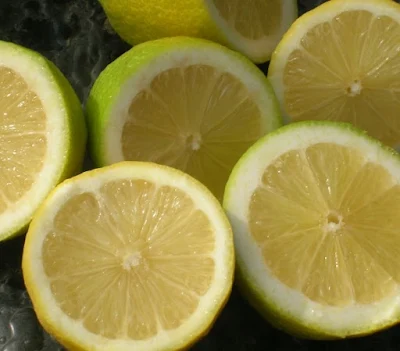The health benefits
of lime include weight loss, skin care, improved digestion, relief from
constipation, eye care, and treatment of scurvy, piles, peptic ulcer,
respiratory disorders, gout, gums, urinary disorders, etc. The first fruit
that comes to mind in terms of medicinal uses is the reliable lime. This sour
citrus fruit can do what many advanced medicines cannot. Lime, bearing the
scientific name Citrus Aurantifolia, has been used for ages in the treatment of
various ailments.
Lime is consumed throughout the world in the form of sorbet,
beverages, refreshing cocktails, pickles, jams, jellies, snacks, candies, sugar
boiled confections and in cooking. The oil extracted from its peel or
skin is extensively used in soft drink concentrates, body oils, cosmetic
products, hair oils, toothpastes, toilet and beauty soaps, disinfectants, mouth
washes, deodorants and innumerable other products. There are many varieties of
lime found all over the world, particularly in the tropical and the
Mediterranean climates.
Lime is very well-known as a cure for scurvy, the disease which is caused
from a deficiency of vitamin-C. It is characterized by frequent infections that
show as normal cold symptoms, cracked lips and lip corners, ulcers on the
tongue and in the mouth. You can also spot scurvy from spongy, swollen and
bleeding gums. Since its cause is a deficiency of vitamin-C, its remedy is none
other than vitamin-C, and lime is full of this essential vitamin.
Lime juice and its natural oils are very beneficial for skin when
consumed orally or applied externally. It rejuvenates the skin, keeps it
shining, protects it from infections and reduces body odor due to the presence
of a large amount of vitamin-C and Flavonoids. Those are both
class-1 anti oxidants, and have antibiotic and disinfectant properties. When
applied externally on skin, its acids scrub out the dead cells, cures dandruff,
rashes, and bruises. It can also be used to create a refreshing bathing
experience if its juice or oil is mixed into your bathing water.
Lime has an irresistible scent which causes your mouth to water and this
actually aids primary digestion (the digestive saliva floods your mouth even
before you taste it). The natural acidity in lime does the rest. While they
break down of the macro molecules of the food, the Flavonoids, the compounds found
in the fragrant oils extracted from lime, stimulate the digestive system and
increase secretion of digestive juices, bile and acids. This flood of
flavonoids also stimulate the peristaltic motion.
Primarily, the ample amount of acids present in lime helps clear the
excretory system by washing and cleaning off the tracts, just as some acids are
used to clean floors and toilets. The roughage in lime is also helpful in easing constipation, but the most beneficial element
is the high acidity. An overdose of lime juice with salt also acts as an excellent
purgative without any side effects, thereby providing relief from constipation.
According to the American Diabetes Association, limes and other citrus
fruits are considered a diabetes super food for a number of reasons. Mainly,
the high levels of soluble fiber found in limes make it an ideal dietary aid to
help regulate the body’s absorption of sugar into the bloodstream, reducing the
occurrence of blood sugar spikes that are a serious risk to diabetic patients.
Also, limes and other citrus fruits have a low glycemic index, which means that
they will not cause unexpected spikes in glucose levels, in addition to the
benefits of soluble fiber’s effect.
That same soluble fiber which can help diabetics maintain their blood
sugar levels can also lower blood pressure and eliminate the presence of LDL
cholesterol (“bad” cholesterol). Furthermore, soluble fiber can cut down on
inflammation of the blood vessels, which is a known preventative measure
against heart disease, heart attacks, and strokes.
One of the many causes of arthritis is an excess of uric acid that builds
up in the body. Uric acid is one of the waste products that normal urination
will clear out of the body, but unfortunately, when too much builds up, it can
make the pain and inflammation from arthritis even worse. The citric acid found
in citrus fruits like limes is a solvent in which uric acid can dissolve,
increasing the amounts that are eliminated in the urine. Citrus fruits in
general have anti-inflammatory properties, and can be used for a number
of inflammation issues.
In addition to vitamin-C, lime contains special
compounds called Flavonoids (Limonoids such as Limonin Glucoside) which have
antioxidant, anti-carcinogenic, antibiotic and detoxifying properties that
stimulate the healing process of peptic and oral ulcers. The flavonoid-rich oil
that is extracted from limes is extensively used in anti-congestive medicines
such as balms, vaporizers, and inhalers due to the presence of Kaempferol. Just
scratching the peel of a lime and inhaling it gives immediate relief for
congestion and nausea.



























